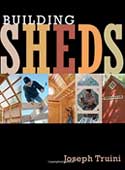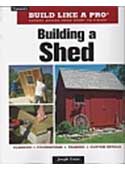You don’t have to settle for metal when it comes to backyard storage.
by Joseph Truini for Today’s HomesOwner Magazine
There’s no denying it: Homeowners collect stuff. We cram it into the crawl space, box it up in the basement and stack it high in the garage. We even park the car out in the driveway and we still don’t have enough storage space to accommodate it all. Sound familiar? Then you might want to consider the benefits of a backyard storage shed.
A dedicated storage building provides a place for mowers, bikes, ladders, tires, garden tools, lumber, old furniture and everything else clogging up your garage. Sheds are also a weatherproof haven for tractors, snow throwers, canoes and garden tillers, as well as for the luggage, steamer trunks, boxes of books and old clothing currently roosting in the attic. There’s even a growing trend toward using larger sheds for everything from potting sheds and playhouses to studios and workshops.
The challenge is finding a shed that’s as attractive as it is useful. Most of the metal storage buildings and prefabricated wood sheds sold at home centers and garden shops are strictly utilitarian (read ugly). Although their low prices are enticing — you can get a 6×8-foot metal shed for less than $170 and an 8×8-foot pine shed for about $295 — with few exceptions, these basic buildings get uglier within a couple of years as they’re exposed to the elements.
Fortunately, a storage shed can be functional, good-looking and durable. We’ve gathered a variety of handsome sheds that fit most any backyard. Some come as ready-to-assemble kits, while others are sold through mail order as plans that guide you or a carpenter you’ve hired through the building process. We’ve focused on wood sheds, which come in the greatest range of sizes, styles and prices. They’re also the most attractive, and just about any homeowner with basic carpentry skills and tools can build one.
There are three basic ways to get a wood shed: Order a set of plans and build it from scratch. Buy a ready-to-assemble kit and build it yourself. Or hire a contractor who specializes in building sheds. You’ll find shed contractors in the yellow pages under “Tool & Utility Sheds,” “Storage Buildings” or “Garage Builders.”
WORKING FROM PLANS – Building a shed yourself from plans is the least-expensive option. Of course, it also entails the most work and time, and requires moderate to advanced carpentry skills. Mail-order shed plans typically cost $20 to $30, and are available from companies that sell home plans. HomeStyles, for example, offers more than two dozen plans for small outbuildings, such as sheds, garages and playhouses. Books on shed building illustrate plans or sell blueprints separately by mail order.
Local shed contractors are another possible source of plans, though most prefer to sell the complete shed. One exception is Better Barns, a Bethlehem, Connecticut, firm that sells plans and materials lists for five different sheds; the price per plan is $29.95. You can get free plans from Georgia-Pacific, Simpson Strong-Tie and many building-product manufacturers, though choices are far more limited.
ASSEMBLING A KIT – Not up to building a shed from scratch? Then consider a ready-to-assemble (RTA) shed. These kits are an appealing compromise between economy and ease. Their large, preassembled panels go together like a jigsaw puzzle. And all the parts are precut, so there’s nothing to saw – even the doors are prehung. In most cases, two people can put up an appealing 8X8-foot RTA shed in a single day. Prices start at around $320.
There are hundreds of small RTA shed companies across the country, though most offer only a handful of designs. Handy Home Products, in Warren, Michigan, is the exception here. The company, which sells RTA sheds throughout the U.S. and Canada, offers 17 styles of sheds in 42 different sizes. When buying an RTA shed, be sure to ask what’s not included in the kit. Usually, you must supply the roof shingles, floor framing and paint or stain.
GETTING IT BUILT – The easiest way to get a backyard storage shed is to hire a local contractor. This is also the most expensive option – figure on $2,000 to $3,000 for a 10X10-foot structure. But this option does provide the greatest design flexibility, because most contractors will alter a style or custom-build a shed to suit your specific property, storage requirements and personal taste. What’s more, once the foundation is set, the contractor usually can build the entire shed in one day by preassembling some of the components in the workshop beforehand.
We tagged along with Peter Charest and his Better Barns crew as they built a 10X12-foot cedar shed in about seven hours. Contractors typically have models available for you to view. Visit them, and use a tape measure to make sure the doorway is wide enough and the ceiling tall enough to suit your storage needs. If models aren’t available, ask for the names of former clients and try to arrange to visit their sheds.
Keep in mind that not all wood sheds are created equal. Those made of untreated pine or fir typically show signs of rot or insect infestation within two years. Look for a shed made of decay-resistant lumber, cedar or redwood. The floor frame and support posts should be pressure-treated wood rated for ground contact, which offers optimum protection from rot and wood-boring bugs.
Pay particular attention to hardware and fasteners. Be sure the doors and windows operate smoothly. And take a close look at the screws, nails and bolts for signs of rust; all metal parts should be made of either hot-dipped galvanized metal or stainless steel.
Whether you decide to use a plan or a ready-to-assemble kit or hire a contractor, consider adding one or more of the following accessories to your shed:
- A ramp, especially if you plan to store a mower, tractor, or bikes;
- enlarged doorways, required for driving in wide tractors and riding mowers;
- built-in shelving to help keep tools and supplies neatly organized;
- a loft for extra storage in the “attic” area, and a workbench, useful in a potting shed or woodworking shop;
- a skylight to brighten the interior, and gable or ridge vents to let hot air escape;
- an extra window, which adds more light, though it also reduces storage space for wall-hung items;
- window screens to keep out insects, especially bees;
- shutters and window boxes, which give the shed a charming cottage look; and
- a cupola with weather vane for a bit of country elegance, especially on larger sheds.
Before building a shed, bring a set of plans to your local building department and apply for a building permit. If you hire a contractor, he can take care of this step for you. In some towns, a building permit is required only for sheds that are larger than 10X12 feet. Check with your building department to be sure. Local building codes also dictate the type of foundation needed. Again, requirements differ from town to town, but in most areas sheds 10X10 feet or smaller can be built on concrete blocks set on the ground. Larger sheds must be supported by poured-concrete footings dug down to the frost line. In most towns, the building inspector must examine the trenches or pier holes before you pour in the concrete.
Siting the shed is another important consideration too many homeowners overlook. “To get the most use out of your shed, keep it close to the driveway or house,” Charest explains. “Kids are much more likely to put away their bikes and sports equipment if the shed is close by.” Never build a shed at the bottom of a hill where water collects. And always leave at least 3 feet of open space around all sides to make room for repairs and allow air to circulate freely.
Which style you choose also brings some practical concerns. For example, sheds with gable roofs offer tall walls that are useful for putting up shelves and hanging long-handled tools. But they provide little headroom when you stand near the walls. Gambrel-style roofs, or barn roofs, have shorter walls but much more headroom. Gary Krska, of Cedar Built in Independence, Missouri, offers a simple solution: “If you like the look of a gambrel roof but need wall storage, order the shed with 7- or 8-foot-tall side walls. That way, you get ample wall storage and extra headroom.”
One final tip if you’re planning to build a shed that’s 10X20 feet or larger: Place the doors in the middle of the sidewall. Doors located in the end gable wall will make it hard to reach items stored at the very back of the shed.
Mention storage sheds, and most people envision old, rusty metal buildings. Unfortunately, that’s a pretty accurate image. Most metal sheds sacrifice quality and structural integrity for low price and quick assembly. A notable exception is Arrow’s 6X8-ft. Ezee Shed (about $375). It’s made of vinyl-coated steel and is backed by a 15-year warranty. The building features snap-in connectors that require 85 percent fewer fasteners than a typical metal shed. As a result, the Ezee Shed can be fully assembled in less than two hours, according to the manufacturer.
If you live in an area that gets a fair amount of snow and you’re thinking of purchasing a metal shed, be sure to buy one that offers a roof-reinforcement kit. It costs $50 to $100 extra, depending on shed size, but can boost the load capacity of the roof by 50 percent.

















